TA5
Module 7 – Cognitive Dissonance Artifact
One I finished the initial survey, I read it back over thinking, “okay, I agreed with everything. This is basically common sense,” and then I read the first question to the second survey and it clicked by the second question. I felt substantially annoyed and uncomfortable and didn’t want to continue, but I finished it nonetheless.
For me personally, I tend to either enter into a state of denial and dismiss my uncomfortable feelings or I try to “reason” myself out of the feeling of dissonance via some form of excuse to lessen the feeling.
I think we feel the need to reduce inconsistency because it’s a very uneasy feeling to know something and to believe it’s true, but to not act or behave on those convictions. You almost begin to question, “well, why don’t I do this?” and you wonder why your beliefs don’t “match up” with your physical actions and behaviors; it really is an “imbalance”.
The question that really brought the full force of cognitive dissonance was the question asking if I have personally done anything to address homelessness in the last year. Incidentally, that was related to my absolute strongest “agree” answer in the prior survey, where asked if homelessness is a serious problem that needs attention.
To “deal” with the cognitive dissonance, I initially felt offended and dismissed the question as invalid. Then I thought about it and asked myself why I hadn’t done anything over the last year. I reasoned that the past year was especially difficult (and it honestly had been) because I had lost my driver’s license, didn’t have an income myself because I couldn’t physically go anywhere (rural area, no transit), and was essentially without a home myself (living with family). These thoughts lessened the dissonance a bit, but then I thought, “well, I have a driver’s license now, I have a job now,” and the feeling was back. From there it was a cycle of attempted reasoning, excuses, and denial until I dismissed the entire internal argument with a distraction.
I can’t say I changed my belief because I still believe homelessness is a real problem, and I can’t say I justified my lack of doing anything about it either; I just accepted that I’m hypocritical and that was that.
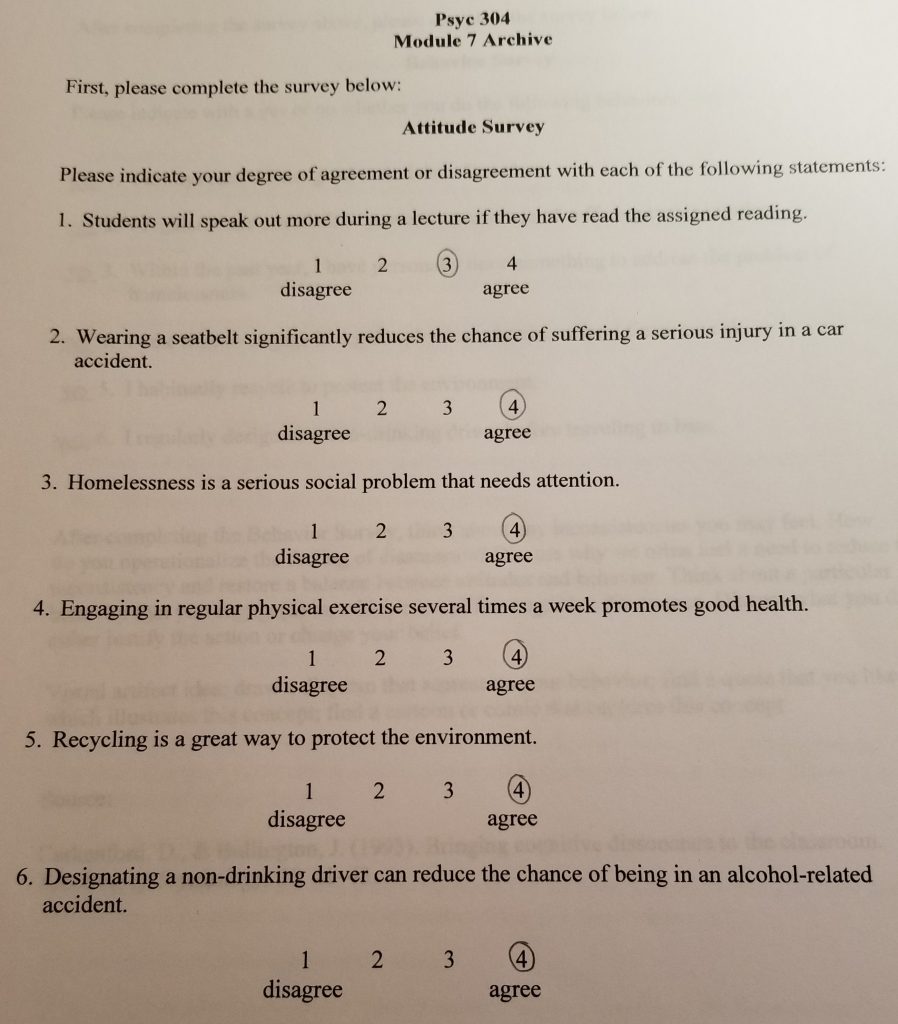
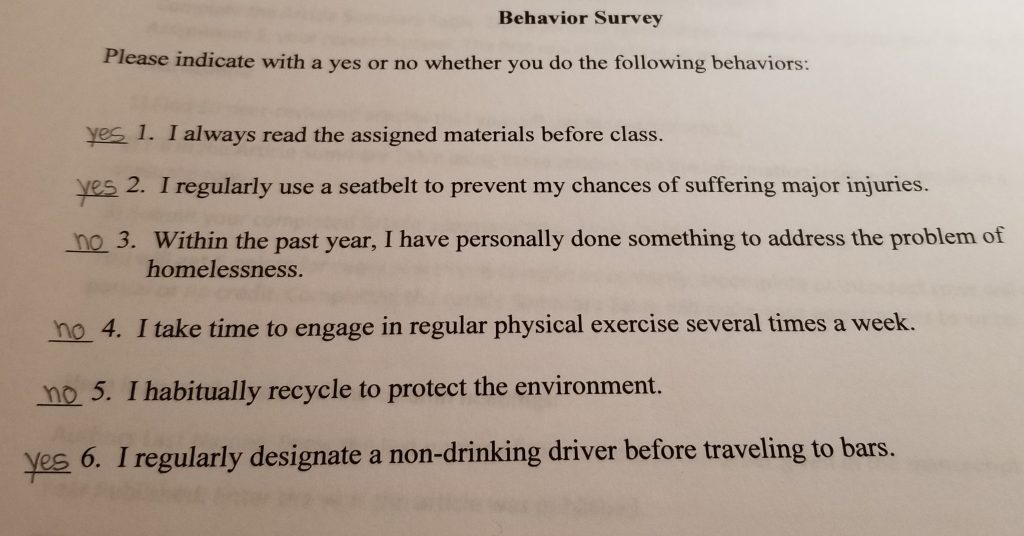
Reflection
I chose this artifact because it left an impression upon me and really made me think. I did not like it when I was doing it, but doing this assignment was pretty unique because doing it actually forces you to experience what you’re learning about. You can read the definition for “cognitive dissonance” and you can understand it from the definition, but in doing this assignment you are forced to feel it. It was a really smart move on whoever put this assignment together to choose questions that most people would readily agree with but may not actually do themselves. I actually did do three out of the six that I agreed with but had the feeling of cognitive dissonance forced upon me with the other three, particularly strongly with the question about homelessness. This was just a really intelligent way to get the definition of “cognitive dissonance” across as more than just a term or a series of words and letters, but an actual feeling that you can remember and revert back to.
TA4
Module 11 – Prosocial Behavior Artifact
Based on my frequency calculation, the pairing that had the greatest tally were people that were “happy” and “unselfish”. I believe that “selfishness” and “happiness” can be perceived as going together under certain circumstances, but under the majority of conditions, most of us in American society are taught to engage in prosocial behavior from a very young age. If you are brought up (with siblings, especially) you were most likely encouraged to share whenever you were being selfish, and that prosocial behavior was further reinforced with praise, smiles, and acknowledgement from parents or other social models. American society, in general, seems to discourage selfish behavior.
I would also speculate that for this exercise, most people would choose family and close friends; i.e., people cosigned to your life by “default”, and close friends in your life by choice. Due to this reason, I speculate that the results would have a higher average percentage (if say, this exercise was conducted in a large population) of people considered “selfish”, than if this exercise was done only keeping friends in mind. The reason being is that I hypothesize most (in my case, all) in the “selfish” category are family; I would speculate that most people probably would not have many selfish friends. Friends are a choice, family is not.

Reflection
I picked this artifact because at the time, the assignment really engaged me to think about what I learned about prosocial behavior and the various reasons why people engage in it, but in the context of people around me I know well, to include both family and close friends. This assignment worked well in conjunction with the final assignment, assignment five. Assignment #5 required you to analyze your own prosocial behavior after being actively encouraged (by the assignment requirement) to engage in it, but this artifact assignment had you analyze the prosocial behavior of those around you. Doing both drove home the benefits of prosocial behavior as, just in the first assignment, it often elicits happiness and a feeling of well-being, even if the reasons are not 100% altruistic.
In the case of observing others around me and gauging their happiness with their either selfish or unselfish behavior, I’ve found that those that are both happy and unselfish (the majority) have found a way to balance their selflessness with the needs of themselves.
Those that I gauged as both unselfish and unhappy were those that were giving up way too much, to the point of being too unselfish; they were not taking themselves into account and were wearing themselves thin doing for others when they needed to do for themselves.
Those that were both “selfish” and “happy” were naïve in a lot of ways about the realities of life; mostly due to youthful ignorance of how the world works.
And finally, those that were “unhappy” and “selfish” were those that believed attaining something in their lives would bring about happiness (no matter how many people they had to step on to get it). To one individual it was riches. They did achieve that goal, but they don’t exactly get a lot of visitors; complaining of the expense of installing an elevator in a 25-room home to those that are struggling to save for car repairs doesn’t breed warm feelings towards such individuals.
Overall, it was clear from my personal observations that the right balance of being unselfish would lead to greater long-term happiness.
TA3
Module 12 – Aggression Artifact
Out of the items that I circled, I think the ones that most indicated aggression to me involved extreme levels of violence or death. For instance, I chose both number 3, “a soldier shoots an enemy on the front line” and number 22, “a bank robber is shot in the back while trying to escape”, as well as number 7, “a man viciously kicks a cat”.
Discussing what aggression involves is so difficult because various kinds of aggression can be viewed quite differently from individual to individual. For my choices, I seem to have viewed aggression involving “duty or job responsibility” in every single case that involved death, but not in any other instance. I also viewed “self-injury” as an aggressive act in case of number 24, “a person commits suicide”.
One thing I did notice when selecting the statements that indicated aggression to me, was that the language mattered a great deal. In number 7, the use of the word “viciously” evokes a more violent visualization of aggression. I questioned why I found number 23, “a tennis player smashes his racket after a missing volley” as aggressive when I didn’t find number 9, “a girl kicks a wastebasket” as aggressive; I realized it was the language: “smashes” evokes more aggression compared to a “kick”, despite both involving “harm to nonliving things”.
It seems that, depending on a variety of factors, aggression can be relative or subjective – and whether or not an action is viewed as “aggressive” in the first place can be dependent on the language used to describe it.
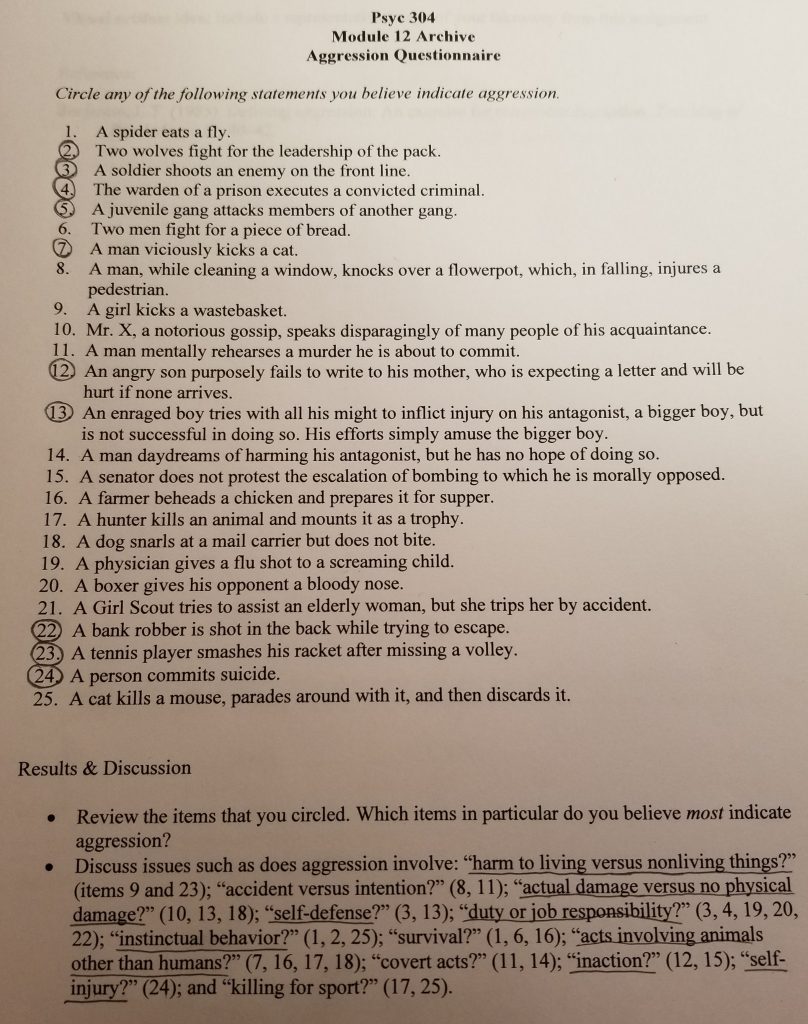
Reflection
I chose this artifact because I believe it really speaks to the social aspect of aggression. In physiological psychology, we learn about aggression and aggressive behavior in humans as a biological process, how the autonomic nervous system reacts to outside influence. But the entire thing about emotions (such as aggression) is that it can be quite subjective. I don’t believe that if the entire class showed what they circled, that a single “aggression questionnaire” would be the same; some may overlap, but I doubt any two students in the class would have the exact same results in what they indicated as aggressive behavior.
TA2
Module 8 – Stereotypes Artifact
After filling out the adjective chart and then comparing my results to those of the 1933 Katz & Braly survey and the 1951 Gilbert survey, it is very apparent that stereotypes change, sometimes drastically, over time.
In terms of my own “adjective picks” for each ethnic and/or racial group, most of my picks were not due to person beliefs and there were even a few groups I don’t personally know or have met (that I’m aware of) and had to reference media representations to come up with a stereotype; in this case, representation in the media can play a large role in the development of stereotypes and the way in which they can change overtime.
One of the most drastic shifts I noticed when comparing results were the stereotypes associated with the Japanese; my adjective picks were “industrious” and “tradition-loving”, and the 1933 survey responses were “intelligent” and “industrious”, but the drastic shift occurs with the 1951 survey responses. In 1951, the Japanese were stereotyped as “deceptive” and “sly”; quite a dramatic shift in stereotypes.
Anyone with minor knowledge of United States history can pin the reason for such a shift in stereotypes: World War II, the bombing of Pearl Harbor, and the use of concentration/internment camps for Japanese-American citizens in the United States.
The stereotypes changed because the group’s position (the Japanese and Japanese-Americans) in American society changed; once “intelligent” and “industrious”, the War shifted the group into an “enemy”, one that couldn’t be trusted to live openly in American society; and since, has shifted again (at least in my personal stereotypes) to “industrious” and “tradition-loving”.
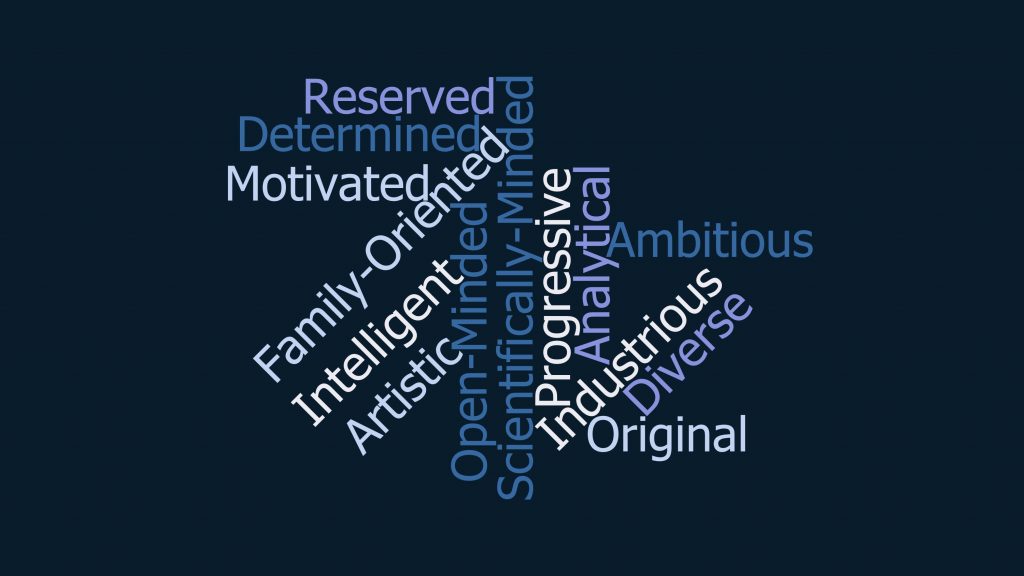
Reflection
I chose this artifact because it was really fascinating to go back and reflect on how stereotypes have changed overtime and it was a reminder of how stereotypes could be “positive” in some ways, and “negative” in some ways. In a little “experiment”, I ended up going back and printing off a couple more adjective column pages because my parents came to town and I asked them to fill it out, and then asked my grandmother to fill it out to compare them to my stereotypes; the idea was to get three generations of stereotypes and compare them further delve into how stereotypes change overtime.
My little “experiment” ended up being widely varied not only because of the generation gaps, but along race: my father black, my mother white, and my grandmother white. The largest variability in answers came from the English and Blacks (awkward) while we all had the exact same answers for the Irish: “quick-tempered” and “religious”.
For the English, my grandmother and mother had more “positive” adjectives; my grandmother: “reserved” and “intelligent”, while my mother chose “intelligent” and “religious”. My father chose “nationalistic” and “deceptive”. Finally, I chose “shrewd” and “reserved”.
Then for Blacks, my grandmother chose “athletic” and “pleasure-loving” (I didn’t quite understand the second adjective, I was a bit surprised by that). My mother chose “musical” and “quick-tempered”. My father chose “athletic” and “musical”. Finally, I chose “family-oriented” and “religious”. There were definitely still some overlaps with the “athletic” and “musical” adjectives, but my choices didn’t match anyone else’s.
In getting so many varied answers based on generation and race, it made me curious as to the variables in the Katz & Braly and Gilbert surveys. The artifact helped me understand the various stereotypes overtime, but taking it a step further with my own little experiment ended up making me ponder more on changing stereotypes, not only over time, but through a variety of other variables.
TA1
Module 4 – Social Cognition Artifact
I believe, or rather know, that the media can play a massive role in our automatic cognitive processing. One of the most interesting points I gathered from the Are We Scaring Ourselves to Death video was the date: 1992. This was so interesting because although a great number of the general public fears were the same (e.g. crime, terrorism, etc.), others have definitely fallen out of favor; you will probably not come across a single teenager or young adult who is concerned about getting brain cancer from their Samsung Galaxy or iPhone, a clear example of the availability heuristic (or rather lack thereof). If the younger generations were never exposed to extensive media coverage attempting to link cell phone usage with brain cancer, a cognitive shortcut would not be created and readily available to access.
The media does still play a substantial role on our availability heuristics in much of the same ways today as in ’92. One of the types of reporting that hasn’t changed are those on all forms of violent crime. Recalling the 2016 presidential election, a focus on one side indicated that crime was skyrocketing, while the other indicated that crime was actually not increasing. Based on the type of news media consumed regularly, the availability heuristic could come into play to misrepresent the likelihood of events like violent crime occurring; most likely an overestimation.
The media can also play a substantial role on our representative heuristics. The video mentioned that the media can inflate acts of terrorism; being in 92, three years prior to the Oklahoma City Bombing, the focus would have most likely been on middle eastern terrorism. That still rings true today: I was in fourth grade when September 11th occurred and was in sixth grade when my father was deployed to Iraq, so news media was followed intently during my formative years.
Despite growing up with friends of a variety of faiths, including followers of Islam, the representative heuristic has formed a correlation of “Muslim” and “terrorist” deep within my automatic cognitive processing due to the influence of the media. It is something I have to manually correct cognitively every time it occurs (which, after years, is not as often). Unfortunately, (to the degree in that it occurs at all) altering the representative heuristic of the word “terrorist” has become easier due to increased media coverage of domestic and right-wing terrorism.
The media, particularly the news media, has played a major role in shaping our “mental shortcuts” by altering our automatic processing over a great length of time.
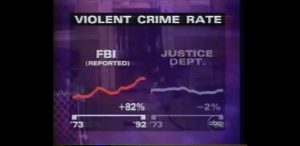
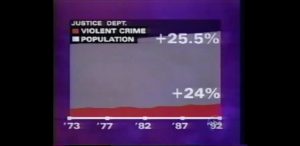
Reflection
I chose this artifact because it was one of my favorites due to the mode of learning: watching a video (especially a documentary video). Watching documentary-format videos tends to help me maintain information a lot better, in conjunction with doing an assignment; such as was required for the artifact. Going over the ways in which the media works on our cognitive shortcuts helped me remember them a lot better and the differences between them. Doing this assignment was very important, not just for learning the material and getting a passing grade in the end, but to be educated and aware of how the news media can alter our perceptions in general. This is knowledge that will be valuable for the rest of my life and the lives of those around me.